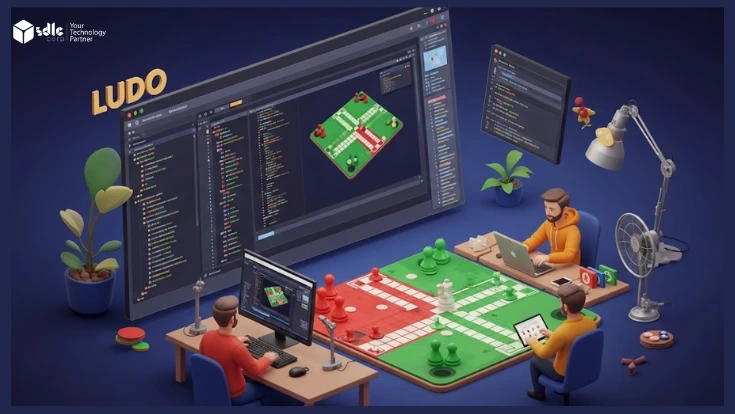Ludo has remained a favorite board game for generations, evolving into a popular digital pastime enjoyed on smartphones and computers around the world. In 2025, the demand for engaging and interactive casual games like Ludo continues to grow exponentially. If you’re considering developing your own Ludo app, one of the most common questions is, “How much will it cost?”
Understanding the full scope of Ludo game development expenses involves delving into design, features, technology, and market trends. This article provides a detailed guide to help you estimate the investment needed for a successful Ludo game project this year.
The Rising Popularity of Ludo Apps in 2025

With millions of users worldwide, digital Ludo games offer a unique blend of nostalgia and modern interactivity. The surge in smartphone penetration and the rise of multiplayer gaming have made Ludo a staple in casual gaming libraries. As players increasingly seek engaging social experiences online, developers have responded by integrating rich features like real-time multiplayer, voice chat, AI opponents, and customizable themes.
This growing complexity naturally influences the Ludo app development cost, making it essential for aspiring developers to plan carefully.
Factors Influencing the Cost of Ludo Game Development

Several critical factors determine the overall investment required for building a Ludo game. Each plays a role in shaping the development timeline and resource allocation, which directly affect cost.
1. Platform Choice
Will the game launch on Android, iOS, web browsers, or all three? Developing for multiple platforms increases costs because each environment requires tailored coding, testing, and optimization. Cross-platform frameworks can reduce expenses but may limit performance or flexibility.
2. Game Features
The core gameplay mechanics of Ludo are simple, but modern users expect additional features to keep the experience engaging. Some popular feature categories include:
- Real-time multiplayer connectivity
- Smart AI opponents for single-player modes
- Voice and emoji chat functionality
- Multiple game modes such as classic, team, and tournament play
- User profile customization and leaderboard systems
More features mean more development hours and testing, leading to a higher cost.
3. UI/UX Design
Design significantly influences user retention. Creating visually appealing boards, tokens, animations, and intuitive navigation requires skilled designers. The Ludo app design cost varies based on the complexity and customization level of the user interface.
4. Backend Infrastructure
Managing multiplayer sessions, real-time data syncing, user authentication, and in-app purchases demands a robust backend system. Scalable servers and efficient database management are essential, especially as the user base grows.
5. Monetization Integration
Incorporating effective Ludo game monetization strategies such as in-app purchases, ads, or subscriptions requires additional development time. Secure payment gateways and ad SDK integration add to the complexity.
6. Development Team Location and Expertise
Hiring experienced developers from different regions influences pricing. Offshore teams may offer cost savings but require clear communication and project management.
7. Testing and Quality Assurance
Rigorous testing across devices and network conditions ensures a smooth player experience. QA specialists add to the overall budget but prevent costly post-launch fixes.
Breaking Down the Cost Components of Ludo App Development

To provide a clearer picture, let’s explore the typical cost ranges for each aspect of Ludo game development in 2025.
| Component | Estimated Cost Range (USD) |
|---|---|
| UI/UX Design | $5,000 – $15,000 |
| Frontend Development | $10,000 – $25,000 |
| Backend Development | $8,000 – $20,000 |
| Real-Time Multiplayer Setup | $5,000 – $15,000 |
| AI Opponent Development | $3,000 – $10,000 |
| Chat Features (Voice/Text) | $2,000 – $7,000 |
| Testing & QA | $3,000 – $8,000 |
| Deployment & Maintenance | $2,000 – $5,000 (initial phase) |
| Total Estimated Cost | $35,000 – $105,000 |
For more detailed insights, you can refer to the Ludo game cost breakdown guide by SDLC Corp.
Understanding the Role of UI/UX in Ludo App Design Cost

The Ludo app design cost isn’t just about aesthetics — it’s about creating an experience that invites players to keep coming back. Design elements that influence cost include:
- Custom illustrations for tokens and boards
- Smooth animations for dice rolls and token movement
- Responsive layouts for different screen sizes
- Intuitive menus and quick navigation
- Theme customization options allowing users to personalize their gameplay
Investing in quality design increases initial costs but pays off by boosting user engagement and retention.
Implementing Robust Monetization Strategies

An important part of building a successful Ludo app is generating revenue. Many developers rely on a combination of Ludo game monetization strategies to maximize income, including:
In-App Purchases (IAP)
Players purchase virtual currency, new token skins, or special game modes. Implementing IAP requires secure transaction handling and a seamless user interface for purchases.
Advertisements
Rewarded video ads and banners can generate passive revenue, especially in free-to-play models. However, balancing ad frequency to avoid disrupting gameplay is essential.
Subscriptions
Offering premium memberships or ad-free experiences encourages long-term revenue and player loyalty.
Real-Money Gaming
Some Ludo apps allow players to compete for cash prizes. This requires regulatory compliance and highly secure payment processing systems.
For more details on profitable models, check SDLC Corp’s post on Ludo game business models and revenue streams.
The Importance of Real-Time Multiplayer and AI in 2025

Players today expect flawless online interactions. Real-time multiplayer capability demands low latency servers and efficient synchronization of player moves. Developing this infrastructure is resource-intensive but critical.
Simultaneously, AI-powered opponents enrich single-player modes by offering competitive gameplay when human opponents aren’t available. Adaptive AI also enhances player satisfaction by adjusting difficulty levels.
To learn more about the entire Ludo game development process from idea to launch, SDLC Corp offers a detailed guide.
The Development Process Step-by-Step

Understanding the workflow helps anticipate costs and timelines:
- Requirement Gathering: Define the core features, target audience, and platforms.
- Wireframing and Design: Develop UI/UX prototypes and receive feedback.
- Frontend and Backend Development: Code the game mechanics, server logic, and user interface.
- Integration of Multiplayer and AI: Implement real-time communication and smart bots.
- Testing and Debugging: Conduct thorough QA to ensure a bug-free experience.
- Deployment: Launch the app on app stores and web platforms.
- Post-Launch Support: Provide updates, fix bugs, and add new content.
Each stage requires coordination among designers, developers, testers, and project managers.
Technologies Commonly Used in Ludo Game Development

Selecting the right technology stack impacts cost and scalability.
- Frontend: React Native, Flutter, Unity, or native Android/iOS development.
- Backend: Node.js, Python (Django/Flask), or Java Spring Boot with real-time frameworks like Socket.IO.
- Database: Firebase, MongoDB, or MySQL for user data and game states.
- Cloud Services: AWS, Google Cloud, or Azure for hosting and scaling multiplayer servers.
Choosing cross-platform frameworks can reduce costs but may limit fine-tuned performance compared to native apps.
Market Trends Impacting Ludo Game Development Costs

The casual gaming sector has seen steady growth, with Ludo games holding strong appeal due to:
- Increasing demand for social gaming experiences
- Integration of voice and video chat features
- Growing interest in tournaments and competitive gaming
- Expansion into new markets with regional language support
To stay relevant, developers must factor these trends into their design and feature sets, often increasing complexity and cost.
For an overview of the top Ludo game development companies to watch in 2025 and trends shaping the industry, check this post.
How to Optimize Costs Without Compromising Quality

Smart budgeting is key to success:
- Start with an MVP: Launch a minimum viable product focusing on core gameplay.
- Iterative Development: Add advanced features based on user feedback and analytics.
- Use Open-Source Tools: Leverage existing libraries and frameworks.
- Outsource Selectively: Combine in-house and offshore resources.
- Focus on User Retention: Prioritize features that enhance long-term engagement.
This approach balances cost and quality, reducing upfront risks.
Conclusion
The cost to develop a Ludo game in 2025 depends on many variables — from design complexity and feature richness to backend robustness and monetization implementation. On average, Ludo app development can range from $35,000 to $105,000 or more depending on your vision and market goals.
By carefully planning your project, incorporating smart Ludo game monetization strategies, and investing appropriately in Ludo app design cost, you can create a compelling and profitable game that captures the attention of millions of players worldwide.
If you’re ready to transform your idea into a dynamic Ludo game app or want professional guidance on the development journey, SDLC Corp is here to help. Our team specializes in creating engaging, scalable, and feature-rich gaming solutions tailored to your needs.
FAQs
What Are The Key Factors That Affect Ludo Game Development Cost?
The cost depends on platform choice, features, UI/UX design, backend infrastructure, monetization integration, development team location, and testing requirements.
How Much Does Ludo App Design Cost Typically Range?
Ludo app design costs can vary from $5,000 to $15,000 depending on the complexity of UI/UX, animations, and customization.
What Are Effective Ludo Game Monetization Strategies?
Popular strategies include in-app purchases, advertisements, subscription models, and real-money gaming options.
Can I Develop A Cross-Platform Ludo Game To Save Costs?
Yes, using frameworks like React Native or Flutter can reduce costs by allowing one codebase for multiple platforms, though with some trade-offs in performance.
How Important Is Real-Time Multiplayer In A Ludo Game?
Real-time multiplayer is crucial for user engagement in Ludo games, but it requires robust backend infrastructure, increasing development complexity and cost.


















